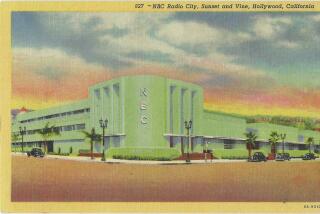Trying to Make a Go of It With ‘Adult Standards’ Radio
KLAC-AM (570) exists in the pre-hip, pre-rock universe. And if hip is “dead,” as some cultural pundits claim, then the road may be paved for the resurgence of square.
KLAC may not embody square as far as its fans are concerned, but it is undeniably in a media world of its own.
KLAC plays the “old” music, a format given the bland label of “Adult Standards” by an industry obsessed with crafting labels for every demographic bump, curl and contour as it applies to the money-spending population.
Certainly the young guns of radio broadcasting care nothing for the format. It is so neglected by local stations that it took a couple of entrepreneurs in Colorado, Bill Moyes and Terry Robinson, to dream up the idea of putting the sounds of Patti Page, Percy Faith, Perry Como, the Kingston Trio--all the throwaways of our mass culture--on one tidy satellite format targeted to attract older Americans in six time zones.
Moyes and Robinson began the Transtar network in Colorado Springs in the early 1980s. Eventually, Westwood One bought the satellite service and, in 1992, KLAC changed from country oldies to the Westwood One adult standards format.
“We get tons of letters saying, ‘Thanks for playing my music; we’re sick of rock music,’ ” said Chick Watkins, Westwood One’s adult standards program director and its weekday morning deejay. “There’s a big void for this kind of music: ‘50s-based oldies, ‘60s pop with some ‘beautiful music’ elements, pretty instrumentals from Ray Coniff.”
Watkins programs the kind of music that used to be the staple of the “middle-of-the-road” (MOR) stations. In Los Angeles, KMPC-AM (710) exemplified the MOR sound heard around the country. Personalities such as Gary Owens, Wink Martindale and Dick Whittinghill mixed humor, information and mass-appeal popular music.
The rock revolution eventually killed that format, stealing the younger listeners and splintering the radio dial into more narrowly defined music categories. KMPC became a talk station in 1992 and, in the last year or so, “K-Joy”--KOJY-AM (540) and KJQI-AM (1260)--became “K-News,” KGRB-AM became Spanish-music KRRA and KXEZ-FM “Easy 100.3” changed to KIBB-FM “B-100.3,” a disco and dance hit station.
*
Culture and politics have nothing to do with this trend. Nor do raw ratings: KLAC has a respectably sized audience. Rather, it is advertisers who are less than enamored with the prospect of reaching the older demographics that the format tends to attract.
“The majority of the [advertiser] buys seem to be in the 25-to-54 demographic, where the buying power is,” said Carole Alverson, vice president and director of spot broadcast at KSL Media in Los Angeles, which buys time for advertisers. “L.A.’s majority is 25-to-54. I don’t get that many requests from advertisers for the 50-plus demo.”
“The industry tends to overlook the older demo,” Watkins agreed. “A lot of the people in advertising overlook 34-to-65 because they tend to be young and they can relate [to the younger-oriented programs]; 25-to-34 is where the money is.”
Whether there is a future for KLAC’s type of music depends on the tastes of young people. Here there seems to be signs of a sea-change in the pop music universe. The political and cultural divide that once separated the generations is narrowing.
“I wouldn’t be surprised if some young people were rejecting today’s rock,” KLAC program director John Sebastian said. “I think that with too many rock and alternative acts, they can’t sing, it’s not melodic, it’s not lyrical. Pop music has always had to have that quality.”
Former K-Joy program director Chuck Southcotte, who now programs the New Music of Your Life satellite network based in Glendale, observes that some young people are drawn to “lounge” music.
“There’s a delightful young singer--Diana Krall,” Southcotte said. “We’re playing her all over the format. She’s only 23 but was raised on the music of Nat ‘King’ Cole. She recently performed at the Derby in Los Feliz. Ninety percent of the people in the room were under 30.”
KLAC production director Marty Miller, who oversees much of the station’s day-to-day operations, said that he receives calls from young people who express a surprising affinity for the pop standards.
The anecdotal evidence, however, does not yet show up in hard data, according to Sebastian. “Is it hip enough that they’d tell their friends?” he asked. “If it were up to me, I’d program it a little younger, a little more contemporary, a little hipper.”
Sebastian, who also tends to the programming of KLAC’s country sister station, KZLA-FM (93.9), admitted he has little control over what Westwood One delivers. But he is determined to move aggressively to promote and build the AM station once the country FM is up to speed, a task that has consumed most of his energies since he arrived at the Chancellor-owned stations last spring.
“We want to make KLAC successful by aggressively marketing it in terms of the Lakers [play-by-play coverage], the pop standards and the [Don] Imus [morning] show,” he said. “Nobody’s ever done much with it.”
One possible route to updating the standards format is to jettison the nostalgia label--KLAC identifies itself as “the memory station”--and present the music without reference to time. This strategy has worked for New York’s WQEW-AM, a standards station owned by the New York Times.
“We never refer to the music as nostalgia,” WQEW station manager Stan Martin said.
Southcotte believes that if Martin’s station were on FM, it would be doing even better. Indeed, KJUL-FM, the Las Vegas station that carries the Westwood One Adult Standards format, hit the No. 1 spot in Arbitron’s ratings for last spring.
More to Read
The biggest entertainment stories
Get our big stories about Hollywood, film, television, music, arts, culture and more right in your inbox as soon as they publish.
You may occasionally receive promotional content from the Los Angeles Times.










